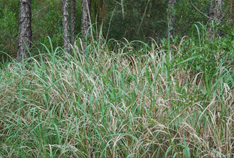
Cogongrass (Imperata cylindrica) is an aggressive colony-forming perennial grass, often forming circular infestations.
Grass is 1-5 ft. tall, often leaning into mats when over 3 ft. tall, tufts of long leaves, yellow-green, blades with off-center midvein, silver plumed flowers and seeds in spring, arising from sharp-tipped white-scaly rhizomes. Flowers in Alabama from February - May. Brown oblong seeds appear May-June and are released within silvery hairy husks for wind dispersal.
Resembles johnsongrass (Sorghum halepense), purpletop (Tridens flavus), silver plumegrass (Saccharum alopecuroides) and sugarcane plumegrasses (S. giganteum), but none have the off-centered whitish midvein and no stem.
Grows in full sunlight to partial shade, and can invade a range of sites. Aggressively invades rights-of-way, new forest plantations, open forests, old fields and pastures. Colonizes by rhizomes and spreads by wind-dispersed seeds. Rapidly growing and branching rhizomes form a dense mat enabling it to exclude most other vegetation. Burns extremely hot, especially in winter, and promoted by burning. Absent in areas with frequent tillage.
Why is it a problem?
Cogongrass is one of the 10 worst weeds in the world. It is steadily marching through Alabama and into neighboring states. This highly invasive pest permanently alters plant and animal communities, increases fire frequency and intensity, and requires extensive investment to control. In other areas of the world cogongrass has destroyed entire landscapes, creating a ‘sea’ of cogongrass with no other plants. Domestic food and fiber supplies are negatively impacted by cogongrass through reduction in wildlife food sources and killing or injuring valuable cash crops such as corn, cotton, and trees. Cogongrass exists on rights-of-way, forests, and agricultural, residential, commercial, and industrial areas. Because it is found in so many areas, there is a need for a large-scale, concerted effort to effectively control it.
How is it treated?
Currently the most effective approach to controlling cogongrass infestations is with repeated chemical application, sometimes over several years. There are numerous herbicides on the market currently labeled for cogongrass. For the latest in cogongrass treatment please read the following papers written by Dr. Jim Miller, USDA Forest Service R&D, Auburn University, and Dr. Stephen F. Enloe, Auburn University.
How do I figure out if I have it on my property?
There are several ways to know if cogongrass is either on your property or a potential threat. First, know how to identify it by going to www.cogongrass.org/cogongrassid.pdf and downloading the field guide. If you prefer you can contact your county forester, extension agent, land manager, or natural resources expert to arrange for them to make the determination.
Additional Resources